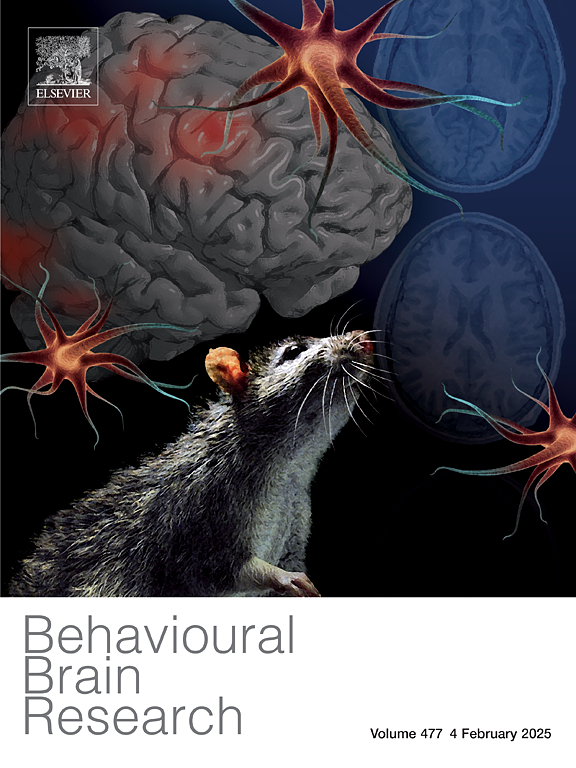Effects of working memory training on cognitive flexibility, dendritic spine density and long-term potentiation in female mice
IF 2.6
3区 心理学
Q2 BEHAVIORAL SCIENCES
引用次数: 0
Abstract
Working memory (WM) is a cognitive ability that allows the short-term maintenance and manipulation of information for goal-directed behavior. The prefrontal cortex (PFC) and the hippocampus (HPC) are two brain regions implicated in WM task performance. Several studies indicate that training in WM (WMT) can enhance performance in various other cognitive tasks. However, our understanding of the neurobiological changes induced by WMT is very limited. Previous work from our lab showed that WMT enhances synaptic and structural plasticity in the PFC and HPC in male mice. In this study, we investigate the effect of WMT on cognitive flexibility and synaptic properties in PFC and HPC in adult female mice. To this end, female adult mice were split into 3 groups: a) mice that remained in their home cage (naïve), b) mice that performed the alternation task in the T-maze (non-adaptive) and c) mice that were trained in the delayed alternation task for 9 days (adaptive). The delayed alternation task was used for WMT. In one cohort, following the delayed alternation task, all mice were tested in the attention set-shifting (AST) task to measure cognitive flexibility, followed by harvesting of the brains for Golgi-Cox staining to study dendritic spine density. Our results showed that in female mice, there were no differences in AST performance among the three groups tested, however, the latency to make a choice was reduced in the adaptive group. With regards to dendritic spine density, no significant differences were identified in PFC while increased dendritic spine density was found in HPC of the adaptive group, compared to the naïve group. In a second cohort, acute brain slices were prepared after completion of the delayed alternation task to investigate the synaptic properties in the PFC and the HPC. Evoked field excitatory post-synaptic potential (fEPSP) recordings were performed in either PFC or HPC brain slices. Our results show that tetanic-induced long-term potentiation (LTP) in the PFC was not different among the three training groups. In the HPC, theta-burst induced LTP was significantly increased in the adaptive group also compared to the non-adaptive and naïve groups. These results reveal both similarities and differences of WMT on performance in the attention set-shifting task, dendritic spine density and LTP in females, compared to males.
工作记忆训练对雌性小鼠认知灵活性、树突棘密度和长时程增强的影响。
工作记忆(WM)是一种认知能力,它允许对目标导向行为的信息进行短期维护和操作。前额叶皮质(PFC)和海马体(HPC)是涉及WM任务表现的两个脑区。一些研究表明,在WMT (WMT)训练可以提高在各种其他认知任务的表现。然而,我们对WMT引起的神经生物学变化的了解非常有限。我们实验室之前的研究表明,WMT增强了雄性小鼠PFC和HPC的突触和结构可塑性。在本研究中,我们研究了WMT对成年雌性小鼠PFC和HPC认知柔韧性和突触特性的影响。为此,雌性成年小鼠被分成3组:a)待在笼子里的小鼠(naïve), b)在t迷宫中执行交替任务的小鼠(非适应性)和c)在延迟交替任务中训练9天的小鼠(适应性)。延迟交替任务用于WMT。在一个队列中,在延迟交替任务之后,所有小鼠都接受了注意力集中转移(AST)任务的测试,以测量认知灵活性,随后采集大脑进行高尔基-考克斯染色,以研究树突脊柱密度。我们的研究结果表明,在雌性小鼠中,三组之间的AST表现没有差异,但适应性组的选择延迟时间缩短了。在树突棘密度方面,与naïve组相比,PFC组无显著差异,而HPC组树突棘密度增加。在第二个队列中,在延迟交替任务完成后制备急性脑切片,以研究PFC和HPC的突触特性。在PFC或HPC脑切片上进行诱发场兴奋性突触后电位(fEPSP)记录。我们的研究结果表明,破伤风引起的PFC长期增强(LTP)在三个训练组之间没有差异。在HPC中,与非适应组和naïve组相比,适应组的theta-burst诱导的LTP也显著增加。这些结果揭示了WMT在注意集转移任务、树突棘密度和LTP方面的异同。
本文章由计算机程序翻译,如有差异,请以英文原文为准。
求助全文
约1分钟内获得全文
求助全文
来源期刊

Behavioural Brain Research
医学-行为科学
CiteScore
5.60
自引率
0.00%
发文量
383
审稿时长
61 days
期刊介绍:
Behavioural Brain Research is an international, interdisciplinary journal dedicated to the publication of articles in the field of behavioural neuroscience, broadly defined. Contributions from the entire range of disciplines that comprise the neurosciences, behavioural sciences or cognitive sciences are appropriate, as long as the goal is to delineate the neural mechanisms underlying behaviour. Thus, studies may range from neurophysiological, neuroanatomical, neurochemical or neuropharmacological analysis of brain-behaviour relations, including the use of molecular genetic or behavioural genetic approaches, to studies that involve the use of brain imaging techniques, to neuroethological studies. Reports of original research, of major methodological advances, or of novel conceptual approaches are all encouraged. The journal will also consider critical reviews on selected topics.
 求助内容:
求助内容: 应助结果提醒方式:
应助结果提醒方式:


